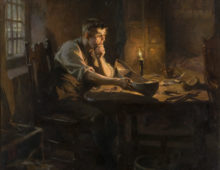Tagged with Politics
Resource : Banner from the “Peterloo Massacre”
On the 16th August 1819, a huge crowd of people gathered in St Peter’s Field, Manchester to hear Henry ‘Orator’ Hunt and other noted radical speakers calling for parliamentary reform. At least 17 people would die of injuries received on the day, and around 700 suffered serious wounds at the hands of local armed forces. There was a popular outcry, and the radical press named the incident the ‘Peterloo Massacre’, a mocking reference to the Battle of Waterloo.
Resource : Red Flag
Today the red flag has, predominantly, become a symbol of socialism and communism. Its European origins date back to the Middle Ages, when a red streamer flying from the mast of a warship signalled a willingness to fight to the death, with no surrender. But its radical political roots lie firmly in the Age of Revolution.
Resource : Luddite ticket
In the early 1700s, work in the textile industry was mainly hand-operated and undertaken by people skilled in crafts – such as weaving and knitting. But innovations in steam power and the design of machinery in the late 18th and early 19th century transformed manufacturing and the way people worked. Much of the new labour could be undertaken by unskilled workers in factories away from the household, quicker than ever before and for a fraction of the price. Skilled textile workers, who found their livelihoods threatened by new, labour-saving technology, responded witha series of violent protests. They became known as the Luddites.
Resource : The Pussyhat
The Pussyhat project is a social movement focused on raising awareness about women’s issues and advancing human rights. Propelled by social media – a revolution in communications – the pussyhat has rapidly become an international symbol for women’s rights, political resistance and collective action.
Resource : Poster advertising the Chartists’ Demonstration on Kennington Common, 1848
The Chartists were members of a national and generally peaceful protest movement who campaigned between 1838 and 1857 for political reform and representation of working class people. It was the first British mass movement to be driven by the working classes. The development of the industrial printing press helped spread the word and gather support for peaceful protests. The Chartists’ ‘demands’ still underpin British democracy today.
Resource : William Wilberforce speaking out against slavery in the House of Lords
The movement to abolish the Transatlantic slave trade was a long and difficult struggle. Campaigners for abolition used every means they could, including sugar boycotts, meetings, petitions, publications, and circulating images showing its shameful nature, to bring the issue to people’s attention in Europe. Enslaved Africans played an essential part, having long resisted their enslavement and treatment through ‘go-slows’, revolts, intellectual and religious claims, and demonstrable capacity to retain and transmit their African or creole (mixed) cultures and languages. Escaped or freed slaves forced judges and social elites to confront the issue through court cases, publications, and performances. Propelled by much of this pressure and evidence, William Wilberforce led the long political campaign to outlaw the slave trade in Britain.
Resource : Rebecca and her daughters
In the late 1830s and early 1840s, a series of riots took place in south and mid Wales. Male farmers and labourers – many of them dressed in women’s clothes – rioted in protest against unfair laws and taxes, low wages and toll roads. The rioters called themselves ‘Rebecca’s daughters’ and their actions became known as the Rebecca riots.
Resource : Figures by Chelsea Waterworks, London, observing the fires of the Gordon Riots, 7 June 1780
The Gordon Riots were a series of anti-Catholic protests which took place in London between 2 and 9 June, 1780. The protests began peacefully but descended into chaos. Crowds paralysed the city with an unparalleled level of violence, with rioters attacking and setting fire to official buildings and people’s homes. The riots are considered by some historians as being the closest Britain has ever come to a full-scale revolution, and shocked fellow European powers.
Resource : The Plumb-Pudding in Danger
This print was one of over a thousand satires produced by the celebrated caricaturist, James Gillray, who became known as the ‘father of the political cartoon’. In the 18th century, cartoons and caricatures were a popular way of mocking the establishment and calling them to account. They would be discussed and enjoyed in shop windows, coffee houses and taverns. The arrival of the industrial printing press in the 1800s helped to spread them far and wide, through broadsides (posters), newspapers and pamphlets. This one was inspired by the resumed hostilities and ongoing rivalry between Britain and France in 1805.
Resource : Five objects from I object: Ian Hislop’s search for dissent
September 7, 2018 - Richard Moss
Ian Hislop has been on a mission to find stories of dissent, subversion and satire hidden within the vast collections of the British Museum for a new exhibition I object: Ian Hislop’s search for dissent. Showcasing over 100 objects that challenge the official version of events and defy established narratives, the items span three millennia […]


